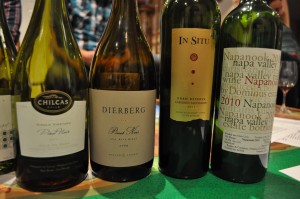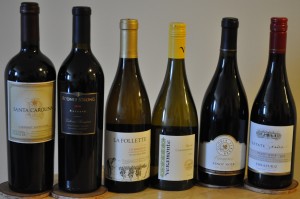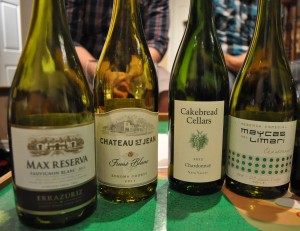PART III – You be the judge
And now the fun part –tasting and tallying! Let’s first discuss how the tasting was conducted.
- Separate groups were assembled on two different evenings with eight and 12 participants, respectively.
- Each group had a distinct flight of wines with six in the first group and eight in the second.
- The participants were told only the following facts, with all else being blind.
o The wines are to be tasted in pairs (A vs B, C vs D, and so on), are of the same grape varietal, but one is from California and the other from Chile.
o The wines’ origins are assembled in the flight in random order, so one cannot assume that the first wine of each pair will always be of the same country.
- The participants were then given their score sheets (as in PART 2 of this series) and were asked to grade the wines as well as take an educated guess on the country of origin, grape varietal and estimated retail price as based on their scoring.
- In general, most participants tasted through the flight in alphabetical order and I placed whites ahead of the reds. I suppose I could have randomly arranged all the wines no matter the colour or weight but I did not want the tasters to suffer palate exhaustion so early.
- Some assumptions were that
o Each taster had a rough idea of the total cost of the flight, given the budget per person.
o The tasters understood the retail market enough to know that in general Chilean wines are priced lower than their Californian counterparts. Nevertheless, they were instructed to grade the wines based on quality.
THE WINES
A: 2010 La Follette Lorenzo Vineyard Chardonnay, Russian River Valley, California ($44.95)
B: 2012 Veramonte Reserva Chardonnay, Casablanca Valley, Chile ($12.95)
C: 2010 Santa Carolina Reserva de Familia Cabernet sauvignon, Maipo Valley, Chile ($18.95)
D: 2010 Rodney Strong Reserve Cabernet sauvignon, Alexander Valley, California ($59.95)
E: 2010 Gloria Ferrer Vineyards Pinot noir, Carneros, California ($26.95)
F: 2010 Errazuriz Estate Reserva Pinot noir, Aconcagua, Chile ($13.95)
Flight 2 (8 wines, 12 tasters)

A: 2013 Errazuriz Estate Max Reserva Sauvignon blanc, Aconcagua, Chile ($15.95)
B: 2011 Château St. Jean Fumé blanc (Sauvignon blanc), Sonoma County, California ($19.95)
C: 2012 Cakebread Cellars Chardonnay, Napa Valley, California ($59.95)
D: 2011 Maycas del Limarí Reserva Especial Chardonnay, Limarí Valley, Chile ($19.95)
E: 2011 Chilcas Single vineyard Pinot noir, Maule Valley, Chile ($17.95)
F: 2009 Dierberg Pinot noir, Santa Rita Hills, California ($47.95)
G: 2010 Dominus Estate Napanook Cabernet sauvignon, Napa Valley, California ($77.95)
H: 2011 Viña San Esteban In situ Gran Reserva Cabernet sauvignon, Aconcagua, Chile ($18.95)
So which country won? All is revealed in Part IV.
PART II – Battle of the Pacific Coast: California vs Chile
It is clear that both countries could each take up multiple issues of the Viniminutes because they are powerhouses in the world of wine in their own right. Here are some interesting facts about the two:
| California | Chile | |
| When did they start growing grapes for wine? | In the late 18th century, Franciscan missionaries planted vines near San Diego. | In the mid 16th century Spanish Conquistadors planted grape planted vines near Santiago. |
| How do they rank in terms of worldwide production?(2012) | The United States ranks 4th worldwide, but California produces almost all of the wine. (2012) | 10th worldwide (2012) |
| …and of exports? | 6th (2011) | 5th (2011) |
| Principal red grapes(by hectares planted and market significance) | Zinfandel (signature grape)
Cabernet sauvignon Pinot Noir Merlot Syrah |
Carmenere (signature grape)
Cabernet sauvigon Merlot Syrah |
| Principal white grapes(by hectares planted and market significance)
|
Chardonnay
Pinot gris Sauvignon blanc |
Sauvignon blanc
Chardonnay |
| Key appelation | Napa Valley | Maipo |
| Claim to fame | Beating out French wine in competition, with a panel of French judges (1976). | Top value for money, second to none. |
| Trials and tribulations | Prohibition of the production and sale of alcohol (1920-1933). | Political unrest and economic downturns (1970s-80s) |
| Significant wine and viticultural research hub | UC Davis Department of viticulture and enology (1935) | Quinta Normal de Agricultura (1850) |
For reference and further reading
http://www.discovercaliforniawines.com
Mogan Stanley Research report on the global wine industry http://blogs.reuters.com/counterparties/files/2013/10/Global-Wine-Shortage.pdf


